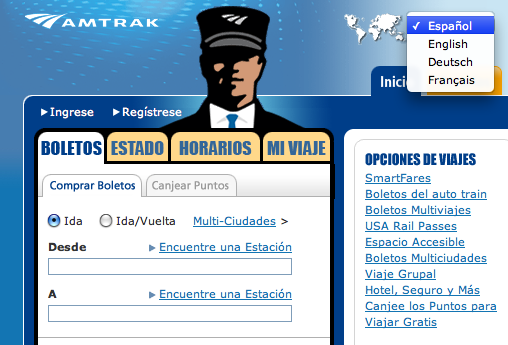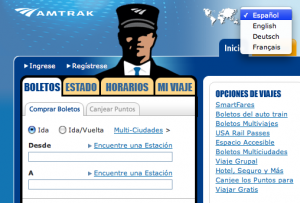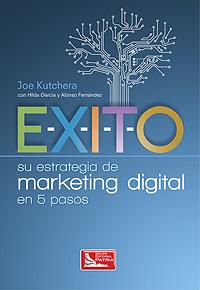This article originally appeared on FoxNews.com.
We all know that U.S. websites offer some of the best content and functionality found online. What happens when one of these websites goes multi-lingual and is offered in Spanish? The story of Amtrak.com provides a surprising illustration of how companies – and even government agencies – can expand sales beyond their “home markets.”
An Unexpected Source of Sales for Amtrak.com
In 2006, Amtrak began offering its complete website in Spanish. Its goal: to serve the large and growing Spanish-speaking audience in the U.S. The site was an immediate success and quickly turned a profit.
While Amtrak’s Spanish website accomplished its goals within the U.S., an Amtrak analyst discovered significant Spanish website sales originating from customers in Spain, Mexico and several other Spanish-speaking countries.
In 2007, Amtrak called MotionPoint – the company that operates the Spanish site – to request a German version. Chuck Whiteman, the senior vice president of client services at MotionPoint, remembers, “We were surprised. Amtrak doesn’t operate trains outside the U.S. and, as far as we knew, wasn’t marketing outside the U.S. either.”
Allen Sebrell, director of e-commerce at Amtrak explains, “The second most spoken language in Europe is German. In addition, outside of North America, Germany is one of Amtrak’s top markets. Our data showed that a high percentage of visitors accessing our website did so from German-speaking countries. For these reasons, in 2007, Amtrak launched a German version of Amtrak.com, which includes all the content and functionality found on both the English and Spanish sites.”
“Both the Spanish and German sites have been very successful and have generated much higher returns on investment than we ever anticipated. They continue to generate strong year-over-year revenue growth,” Sebrell says. Amtrak added a French site in 2010 that, like the Spanish and German sites, has also been very successful.
Latent Demand for “World-Class Websites”
Amtrak’s experience is not uncommon. According to Whiteman, “Our clients are often surprised by the traffic their translated sites attract from around the world – even from markets they don’t ship to.”
English speakers, in general, enjoy the best the Internet has to offer because they happen to speak the primary language of the world’s largest market. When an English website offers another language, previously underserved users often find the deep content, robust functionality and more competitive prices appealing. While the worldwide Web connects people with websites from anywhere in the world, users more often find, use, and make purchases on sites that they can read and understand in their own language.
Customization Engine
MotionPoint measures user behavior across a range of industries, markets and languages due to the fact that it operates localized versions of websites for hundreds of well-known brands such as Best Buy, Urban Outfitters, and Victoria’s Secret.
Whiteman describes his company as a “customization engine for websites” even though a casual observer might think of MotionPoint as a “translation company.” But with everything that goes on behind the HTML of an international website, a “customization engine” better reflects what MotionPoint does, including search engine optimization, content management, website hosting, and geo-localization.
“Domestic Spanish-speakers online represent the lowest-hanging fruit for U.S.-based retailers,” Whiteman says. “In fact, we typically see higher conversion rates and average order values among U.S. Hispanics because they’ve historically been so underserved. They react very well when they experience a world-class website in Spanish.”
Once a website is translated into Spanish, Spaniards or Latin Americans often find U.S. sites in Spanish through search and, increasingly, social media, and want to make purchases. For example, Best Buy accepts international credit cards because of the demand the company discovered from Mexico and the rest of Latin America.
MotionPoint translates websites into 36 languages, of which Spanish is the most popular among domestic e-tailers. Since MotionPoint hosts its clients’ translated websites, the company gathers deep insights into global e-commerce. Its Web analytics team reports that international, non-U.S. audiences often spend more time on its e-tailer client sites than domestic audiences. Since fewer options on the Web exist south of the border, when Latin Americans find a website with high-quality content in Spanish, they spend more time there.
The same is true of sales conversions online. MotionPoint’s clients see that U.S. Hispanics’ purchase rates typically supersede the domestic average. In contrast, international users normally face barriers like international shipping costs and higher taxes and therefore often have lower conversion rates. But when they find a translated site that has been customized into a local currency with an explanation of shipping costs and logistics, international purchase rates approach domestic ones.
E-Commerce Growth in Latin America
Many of MotionPoint’s U.S. Hispanic e-tail sites receive 25% and sometimes even a majority of their traffic from Latin America due to the enormous growth in the region. According to Euromonitor International, Latin America achieved the highest growth rates globally between 2006 and 2011 with a 27.9% compound annual growth rate and total sales reaching more than $15 billion in 2011. North America and Australia saw the lowest. Looking ahead, Latin America will register the strongest e-commerce growth globally during the next five years reaching more than $29 billion in 2016. An increase in online users and improvements in infrastructure will drive online growth in Latin America with such advances as faster broadband services, higher household PC and laptop penetration, and improvements in payment and delivery services.
Sears Holdings owns and operates three Spanish-language websites: its U.S. Hispanic website, its site for Puerto Rico and its international website. Oscar Castro, the director and general manager of international e-commerce at Sears Holdings, says, “Given how much of the world’s population lives outside of the United States, international e-commerce is clearly a big opportunity. Technology provides people unprecedented access to goods, information and other people. As market leaders in e-commerce, we at Sears Holdings leverage technology to serve customers around the world, in multiple languages. We are proud to offer more than a million products to more than 90 countries worldwide.” Following is a screen shot of Sears’ international website.
Global E-Commerce Challenges
While the benefits are clear, international e-commerce may introduce complexities for retailers such as managing pricing in different currencies, vendor restrictions, collecting tariffs and duties, accepting different payment types, managing fraud and returns, as well as overcoming complexities in outbound fulfillment and product delivery.
Vendors like FiftyOne enable retailers to eliminate many of these complexities so that they can transact with cross-border shoppers in the more than 100 markets it delivers to worldwide. FiftyOne makes these transactions more fluid between the customer and retailer by not only providing currency conversion, but also managing international logistics and actually taking control of the inventory for part of the shipping process.
For example, a customer from Mexico will typically see the Mexican flag on the upper right corner of a FiftyOne-enabled website and all of the prices will be displayed in Mexican pesos. Oftentimes, a landing page welcomes the international visitor – explaining shipping or credit card policies. FiftyOne is also able to suppress products that are not available for international shipment.
Kevin Frisch, the senior vice president and general manager consumer with FiftyOne Global Ecommerce, says that after six months of fine-tuning an internationally optimized website, its clients begin generating international sales results, which grows to about 10% of its clients’ total e-commerce revenues.
As an example of FiftyOne’s work, Williams-Sonoma’s website offers shipping to more than 95 local markets.
Fewer Returns
On the upside, FiftyOne finds that cross-border shoppers rarely return their purchases, according to its recent study of more than half a million orders that the company fulfilled. Why don’t cross-border shoppers return as much as domestic online shoppers? International returns can be more complicated and costly. In addition, research suggests that buyers outside the U.S. simply aren’t accustomed to returning what they order.
Claim Your International Customers
Translating and optimizing your site for international e-commerce unlocks latent demand from global consumers. Amtrak.com was surprised that it could grow its sales with not only Spanish, but also German and French-speaking consumers – something the company never expected.
Google launched country-specific versions of its websites early in its history so that no one would copy them. In contrast, Groupon spawned international copycats and subsequently had to buy several of them to maintain a leadership position globally. Will you claim your international market? Or will someone else claim your market by duplicating your business in new languages and currencies?
Finding the Right International Markets
In conclusion, identifying the right target markets isn’t as simple as pulling a list of the largest economies. The opportunity is a function of your current offering as well as analyzing the number and quality of your competitors in every market.
When developing a business case for your international sales, break out the non-U.S. traffic coming to your English website. “If you see a significant amount of traffic coming from a particular country, use that as a reason to dig deeper,” Whiteman says. “Current existing traffic from foreign countries to a company’s English website reveals latent demand. By comparing relative traffic volumes with direct competitors, you can identify markets where your brand already has a foothold and latent demand is the strongest.”










